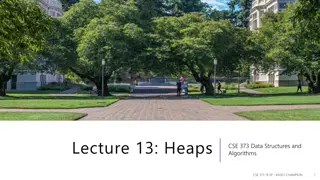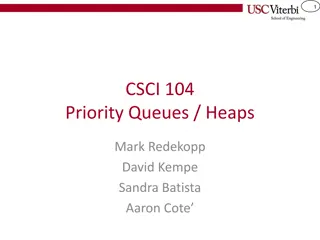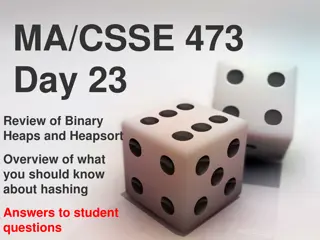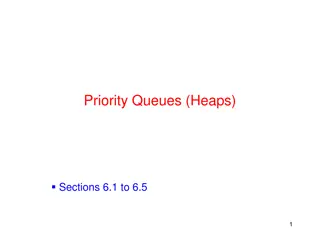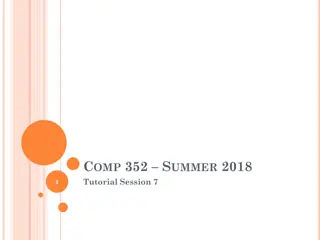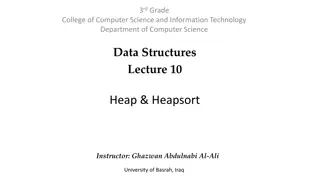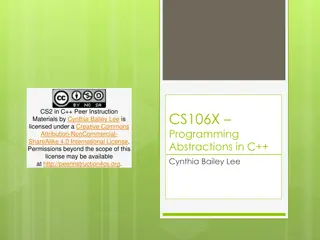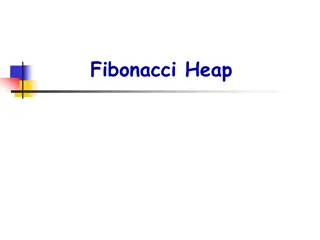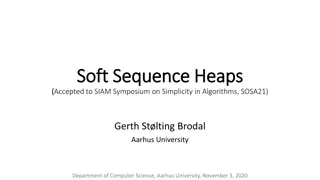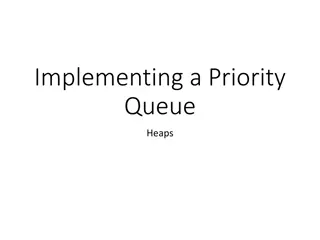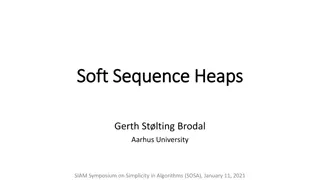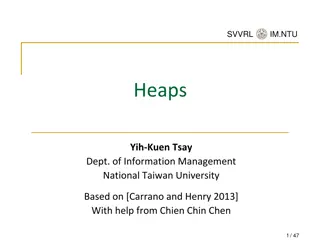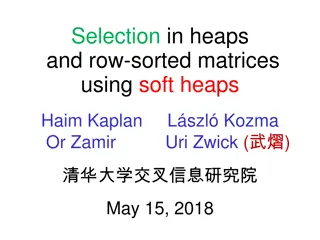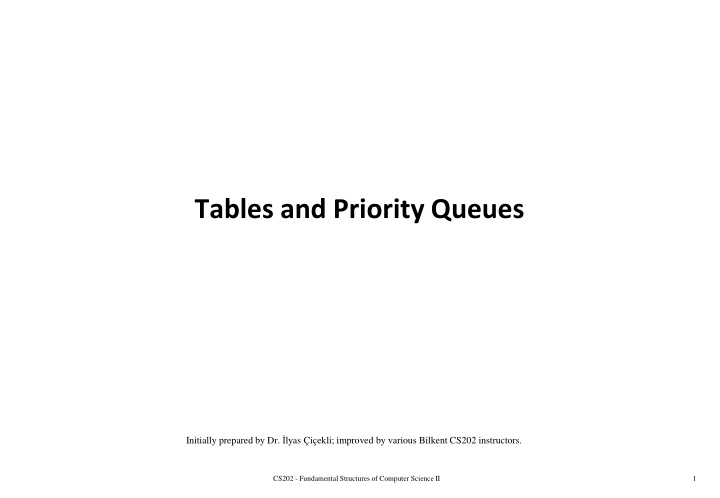
Tables and Priority Queues
Learn about the fundamentals of managing data using tables and priority queues in computer science. Explore different table implementations, operations, and key considerations for selecting the right implementation for your application needs.
Download Presentation

Please find below an Image/Link to download the presentation.
The content on the website is provided AS IS for your information and personal use only. It may not be sold, licensed, or shared on other websites without obtaining consent from the author. If you encounter any issues during the download, it is possible that the publisher has removed the file from their server.
You are allowed to download the files provided on this website for personal or commercial use, subject to the condition that they are used lawfully. All files are the property of their respective owners.
The content on the website is provided AS IS for your information and personal use only. It may not be sold, licensed, or shared on other websites without obtaining consent from the author.
E N D
Presentation Transcript
Tables and Priority Queues Initially prepared by Dr. lyas i ekli; improved by various Bilkent CS202 instructors. CS202 - Fundamental Structures of Computer Science II 1
Tables Appropriate for problems that must manage data by value. Some important operations of tables: Inserting a data item containing the value x. Delete a data item containing the value x. Retrieve a data item containing the value x. An ordinary table of cities Various table implementations are possible. We have to analyze the possible implementations so that we can make an intelligent choice. Some operations are implemented more efficiently in certain implementations. CS202 - Fundamental Structures of Computer Science II 2
Table Operations Some of the table operations are possible: - - - - - - - - Create an empty table Destroy a table Determine whether a table is empty Determine the number of items in the table Insert a new item into a table Delete the item with a given search key Retrieve the item with a given search key Traverse the table The client may need a subset of these operations or require more Are keys in the table are unique? We will assume that keys in our tables are unique. But, some other tables allow duplicate keys. CS202 - Fundamental Structures of Computer Science II 3
Selecting an Implementation Since an array or a linked list represents items one after another, these implementations are called linear. There are four categories of linear implementations: Unsorted, array based (an unsorted array) Unsorted, pointer based (a simple linked list) Sorted (by search key), array based (a sorted array) Sorted (by search key), pointer based (a sorted linked list). We have also nonlinear implementations such as binary search trees. Binary search tree implementation offers several advantages over linear implementations. CS202 - Fundamental Structures of Computer Science II 4
Sorted Linear Implementations Array-based implementation Pointer-based implementation CS202 - Fundamental Structures of Computer Science II 5
A Nonlinear Implementation Binary search tree implementation CS202 - Fundamental Structures of Computer Science II 6
Which Implementation? It depends on our application. Answer the following questions before selecting an implementation. 1. What operations are needed? Our application may not need all operations. Some operations can be implemented more efficiently in one implementation, and some others in another implementation. 2. How often is each operation required? Some applications may require many occurrences of an operation, but other applications may not. For example, some applications may perform many retrievals, but not so many insertions and deletions. On the other hand, other applications may perform many insertions and deletions. CS202 - Fundamental Structures of Computer Science II 7
How to Select an Implementation Scenario A Scenario A: Let us assume that we have an application: Inserts data items into a table. After all data items are inserted, traverses this table in no particular order. Does not perform any retrieval and deletion operations. Which implementation is appropriate for this application? Keeping the items in a sorted order provides no advantage for this application. In fact, it will be more costly for this application. Unsorted implementation is more appropriate. CS202 - Fundamental Structures of Computer Science II 8
How to Select an Implementation Scenario A Which unsorted implementation (array-based, pointer-based)? Do we know the maximum size of the table? If we know the expected size is close to the maximum size of the table an array-based implementation is more appropriate (because a pointer-based implementation uses extra space for pointers) Otherwise, a pointer-based implementation is more appropriate (because too many entries will be empty in an array-based implementation) Time complexity of insertion in an unsorted list: O(1) CS202 - Fundamental Structures of Computer Science II 9
How to Select an Implementation Scenario B Scenario B: Let us assume that we have an application: Performs many retrievals, but few insertions and deletions E.g., a thesaurus (to look up synonyms of a word) For this application, a sorted implementation is more appropriate We can use binary search to access data, if we have sorted data. A sorted linked-list implementation is not appropriate since binary search is not practical with linked lists. If we know the maximum size of the table a sorted array-based implementation is more appropriate for frequent retrievals. Otherwise a binary search tree implementation is more appropriate for frequent retrievals. (in fact, balanced binary search trees will be used) CS202 - Fundamental Structures of Computer Science II 10
How to Select an Implementation Scenario C Scenario C: Let us assume that we have an application: Performs many retrievals as well as many insertions and deletions. ? Sorted Array Implementation Retrievals are efficient. But insertions and deletions are not efficient. a sorted array-based implementation is not appropriate for this application. ? Sorted Linked List Implementation Retrievals, insertions, and deletions are not efficient. a sorted linked-list implementation is not appropriate for this application. ?Binary Search Tree Implementation Retrieval, insertion, and deletion are efficient in the average case. a binary search tree implementation is appropriate for this application. (provided that the height of the BST is O(logn)) CS202 - Fundamental Structures of Computer Science II 11
Which Implementation? Linear implementations of a table can be appropriate despite its difficulties. Linear implementations are easy to understand, easy to implement. For small tables, linear implementations can be appropriate. For large tables, linear implementations may still be appropriate (e.g., for the case that has only insertions to an unsorted table--Scenario A) In general, a binary search tree implementation is a better choice. Worst case: O(n) Average case: O(log2n) for most table operations for most table operations Balanced binary search trees increase the efficiency. CS202 - Fundamental Structures of Computer Science II 12
Which Implementation? The average-case time complexities of the table operations CS202 - Fundamental Structures of Computer Science II 13
Binary Search Tree Implementation TableB.h #include "BST.h"// Binary search tree operations typedef TreeItemType TableItemType; class Table { public: Table(); // copy constructor and destructor are supplied by the compiler // default constructor bool tableIsEmpty() const; int tableLength() const; void tableInsert(const TableItemType& newItem) throw(TableException); void tableDelete(KeyType searchKey) throw(TableException); void tableRetrieve(KeyType searchKey, TableItemType& tableItem) const void traverseTable(FunctionType visit); throw(TableException); protected: void setSize(int newSize); private: BinarySearchTree bst; int size; } // BST that contains the table s items // Number of items in the table CS202 - Fundamental Structures of Computer Science II 14
Binary Search Tree Implementation tableInsert #include "TableB.h"// header file void Table::tableInsert(const TableItemType& newItem) throw(TableException) { try { bst.searchTreeInsert(newItem); ++size; } catch (TreeException e){ throw TableException("Cannot insert item"); } } CS202 - Fundamental Structures of Computer Science II 15
The Priority Queue Priority queue is a variation of the table. Each data item in a priority queue has a priority value. Using a priority queue we prioritize a list of tasks: Job scheduling Major operations: Insert an item with a priority value into its proper position in the priority queue. Deletionis not the same as the deletion in the table. We delete the item with the highest priority. CS202 - Fundamental Structures of Computer Science II 16
Priority Queue Operations create creates an empty priority queue. destroy destroys a priority queue. isEmpty determines whether a priority queue is empty or not. insert inserts a new item (with a priority value) into a priority queue. delete retrieves the item in a priority queue with the highest priority value, and deletes that item from the priority queue. CS202 - Fundamental Structures of Computer Science II 17
Which Implementations? 1. Array-based implementation Insertion will be O(n) 2. Linked-list implementation Insertion will be O(n) 3. BST implementation Insertion is O(log2n) in average but O(n) in the worst case. We need a balanced BST so that we can get better performance [O(logn) in the worst case] HEAP CS202 - Fundamental Structures of Computer Science II 18
Heaps Definition:A heap is a complete binary tree such that It is empty, or Its root contains a search key greater than or equal to the search key in each of its children, and each of its children is also a heap. Since the root contains the item with the largest search key, heap in this definition is also known as maxheap. On the other hand, a heap which places the smallest search key in its root is know as minheap. We will talk about maxheap as heap in the rest of our discussions. CS202 - Fundamental Structures of Computer Science II 19
Heap Data Structure 16 14 10 h h-1 8 7 9 3 2 4 1 Complete binary tree Completely filled on all levels except possibly the lowest level The lowest level is filled from left to right 20 CS 202
Heap Property: Min-Heap 1 2 4 The smallest element in any subtree is the root element in a min-heap 3 7 9 8 10 14 16 Min heap: For every node i other than root, A[parent(i)] A[i] Parent node is always smaller than the child nodes 21 CS 202
Heap Property: Max-Heap 16 14 10 The largest element in any subtree is the root element in a max-heap 8 7 9 3 2 4 1 We will focus on max-heaps Max heap: For every node i other than root, A[parent(i)] A[i] Parent node is always larger than the child nodes 22 CS 202
Differences between a Heap and a BST A heap is NOT a binary search tree. 1. A BST can be seen as sorted, but a heap is ordered in much weaker sense. Although it is not sorted, the order of a heap is sufficient for the efficient implementation of priority queue operations. 2. A BST has different shapes, but a heap is always complete binary tree. 50 50 50 HEAPS 40 45 40 40 45 35 33 30 50 42 50 NOT HEAPS 40 40 45 40 35 30 CS202 - Fundamental Structures of Computer Science II 23
Heap Data Structure 0 16 1 2 Heap can be stored in a linear array 14 10 3 4 5 6 8 7 9 3 7 8 9 Storage 2 4 1 0 1 2 3 4 5 6 7 8 9 16 14 10 8 7 9 3 2 4 1 items 24 CS 202
Heap Data Structure 0 The links in the heap are implicit: 16 1 2 = i + i ( ) 2 = i 1 + left i i 14 10 ( ) 2 = 2 i right 3 4 5 6 / ) 1 ( ) ( 2 parent 8 7 9 3 7 8 9 Storage 2 4 1 0 1 2 3 4 5 6 7 8 9 16 14 10 8 7 9 3 2 4 1 items 25 CS 202
Heap Data Structure = i + ( ) 2 1 left i 0 e.g. Left child of node 3 has index 7 16 1 2 = i + ( ) 2 2 right i 14 10 e.g. Right child of node 1 has index 4 3 4 5 6 8 7 9 3 2 = i / ) 1 ( ) ( parent i 7 8 9 e.g. Parent of node 6 has index 2 2 4 1 0 1 2 3 4 5 6 7 8 9 16 14 10 8 7 9 3 2 4 1 items 26 CS 202
Heap Data Structure items[0] is always the root element Array items has two attributes: MAX_SIZE: Size of the memory allocated for array items size: The number elements in heap at a given time size MAX_SIZE 27 CS 202
Major Heap Operations Two major heap operations are insertion and deletion. Insertion Inserts a new item into a heap. After the insertion, the heap must satisfy the heap properties. Deletion Retrieves and deletes the root of the heap. After the deletion, the heap must satisfy the heap properties. CS202 - Fundamental Structures of Computer Science II 28
Heap Delete First Step The first step of heapDelete is to retrieve and delete the root. This creates two disjoint heaps. CS202 - Fundamental Structures of Computer Science II 29
Heap Delete Second Step Move the last item into the root. The resulting structure may not be heap; it is called as semiheap. CS202 - Fundamental Structures of Computer Science II 30
Heap Delete Last Step The last step of heapDelete transforms the semiheap into a heap. Recursive calls to heapRebuild CS202 - Fundamental Structures of Computer Science II 31
Heap Delete max= 0 heapDelete (items, size) max items[0] items[0] items[size-1] size size 1 heapRebuild(items, 0, size) return max 16 1 2 14 10 3 4 5 6 8 7 9 3 7 8 9 2 4 1 Return the max element, and reorganize the heap to maintain heap property 32 CS 202
Rebuild Heap Heap property violated at the root Maintaining heap property: 0 1 Subtrees rooted at left(i) and right(i) are already heaps. 1 2 14 10 But, items[i] may violate the heap property (i.e., may be smaller than its children) 3 4 5 6 8 7 9 3 7 8 Idea: Float down the value at items[i] in the heap so that subtree rooted at i becomes a heap. 2 4 Heap property satisfied for left and right subtrees 33 CS 202
Rebuild Heap rebuildHeap(items, 0, 9) 0 1 1 2 14 10 3 4 5 6 8 7 9 3 7 8 2 4 recursive call 34 CS 202
Rebuild Heap recursive call: rebuildHeap(items, 1, 9) 0 14 1 1 2 10 3 4 5 6 8 7 9 3 7 8 2 4 recursive call 35 CS 202
Rebuild Heap recursive call: rebuildHeap(items, 3, 9) 0 14 1 8 2 10 3 1 4 5 6 7 9 3 7 8 2 4 recursive call (base case) 36 CS 202
Rebuild Heap: Summary (Floating Down the Value) rebuildHeap(items, 0, 9) 0 1 1 2 14 10 3 4 5 6 8 7 9 3 7 8 2 4 37 CS 202
Heap Operations: Rebuild Heap after rebuildHeap: 0 14 1 8 2 10 3 4 4 5 6 7 9 3 7 8 2 1 38 CS 202
Heap Delete ANALYSIS Since the height of a complete binary tree with n nodes is always log2(n+1) heapDeleteis O(log2n) CS202 - Fundamental Structures of Computer Science II 39
Heap Insert A new item is inserted at the bottom of the tree, and it trickles up to its proper place ANALYSIS Since the height of a complete binary tree with n nodes is always log2(n+1) heapInsertis O(log2n) CS202 - Fundamental Structures of Computer Science II 40
Heap Implementation constint MAX_HEAP = maximum-size-of-heap; #include "KeyedItem.h"// definition of KeyedItem typedef KeyedItem HeapItemType; class Heap { public: Heap(); // copy constructor and destructor are supplied by the compiler // default constructor bool heapIsEmpty() const; void heapInsert(const HeapItemType& newItem) throw(HeapException); void heapDelete(HeapItemType& rootItem) throw(HeapException); protected: void heapRebuild(int root); private: HeapItemType items[MAX_HEAP]; int size; }; // Converts the semiheap rooted at // index root into a heap // array of heap items // number of heap items CS202 - Fundamental Structures of Computer Science II 41
Heap Implementation // Default constructor Heap::Heap() : size(0) { } boolHeap::heapIsEmpty() const { return (size == 0); } CS202 - Fundamental Structures of Computer Science II 42
Heap Implementation -- heapInsert void Heap::heapInsert(constHeapItemType&newItem) throw(HeapException) { if (size >= MAX_HEAP) throw HeapException("HeapException: Heap full"); // Place the new item at the end of the heap items[size] = newItem; // Trickle new item up to its proper position int place = size; int parent = (place - 1)/2; while ( (place > 0) && (items[place].getKey() > items[parent].getKey()) ) { HeapItemType temp = items[parent]; items[parent] = items[place]; items[place] = temp; } } ++size; place = parent; parent = (place - 1)/2; CS202 - Fundamental Structures of Computer Science II 43
Heap Implementation -- heapDelete Void Heap::heapDelete(HeapItemType&rootItem) throw(HeapException) { if (heapIsEmpty()) throwHeapException("HeapException: Heap empty"); else { rootItem = items[0]; items[0] = items[--size]; heapRebuild(0); } } CS202 - Fundamental Structures of Computer Science II 44
Heap Implementation -- heapRebuild voidHeap::heapRebuild(int root) { int child = 2 * root + 1; if ( child < size ) { // root is not a leaf so that it has a left child int rightChild = child + 1; // index of root's left child, if any // index of a right child, if any // If root has right child, find larger child if ( (rightChild < size) && (items[rightChild].getKey() >items[child].getKey()) ) child = rightChild; // index of larger child // If root s item is smaller than larger child, swap values if ( items[root].getKey() < items[child].getKey() ) { HeapItemType temp = items[root]; items[root] = items[child]; items[child] = temp; // transform the new subtree into a heap heapRebuild(child); } } CS202 - Fundamental Structures of Computer Science II 45
Heap Implementation of PriorityQueue The heap implementation of the priority queue is straightforward Since the heap operations and the priority queue operations are the same. When we use the heap, Insertion and deletion operations of the priority queue will be O(log2n). CS202 - Fundamental Structures of Computer Science II 46
Heap Implementation of PriorityQueue #include "Heap.h"// ADT heap operations typedef HeapItemType PQItemType; class PriorityQueue { public: // default constructor, copy constructor, and destructor // are supplied by the compiler // priority-queue operations: bool pqIsEmpty() const; void pqInsert(const PQItemType& newItem) throw (PQException); void pqDelete(PQItemType& priorityItem) throw (PQException); private: Heap h; }; CS202 - Fundamental Structures of Computer Science II 47
Heap Implementation of PriorityQueue bool PriorityQueue::pqIsEmpty() const { return h.heapIsEmpty(); } void PriorityQueue::pqInsert(const PQItemType& newItem) throw (PQException){ try { h.heapInsert(newItem); } catch (HeapException e) { throw PQueueException("Priority queue is full"); } } void PriorityQueue::pqDelete(PQItemType& priorityItem) throw (PQException) { try { h.heapDelete(priorityItem); } catch (HeapException e) { throw PQueueException("Priority queue is empty"); } } CS202 - Fundamental Structures of Computer Science II 48
Heap or Binary Search Tree? CS202 - Fundamental Structures of Computer Science II 49
Heapsort We can make use of a heap to sort an array: 1. Create a heap from the given initial array with n items. 2. Swap the root of the heap with the last element in the heap. 3. Now, we have a semiheap with n-1 items, and a sorted array with one item. 4. Using heapRebuild convert this semiheap into a heap. Now we will have a heap with n-1 items. 5. Repeat the steps 2-4 as long as the number of items in the heap is more than 1. CS202 - Fundamental Structures of Computer Science II 50






